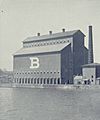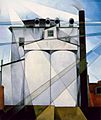Grain elevator facts for kids
A grain elevator is a special building or group of buildings used to store huge amounts of grain, like wheat, corn, or soybeans. Think of it as a giant pantry for crops! These places are super important in the grain trade because they help farmers store their harvests safely until they can be sold or shipped.
The term "grain elevator" can mean a few things. It often refers to the tall tower that has a special machine inside, like a bucket elevator or a pneumatic conveyor. This machine acts like a giant scoop, lifting grain from a lower level and dropping it into a big storage container called a silo. But "grain elevator" can also describe the whole complex, which includes offices, scales for weighing trucks, and all the storage buildings. Sometimes, it even refers to the companies that run many of these storage places in different areas.
Before grain elevators were invented, grain was usually moved around in bags. This was a lot of hard work! But then, in 1842 and 1843, a merchant named Joseph Dart and an engineer named Robert Dunbar came up with a brilliant idea in Buffalo, New York. They invented something called the marine leg. This amazing machine could scoop loose grain right out of ships and lift it high up into a storage tower. This invention, called Dart's Elevator, changed how grain was handled forever!
Contents
How Grain Elevators Work
Grain elevators are designed to move and store grain efficiently. They use different parts to get the grain where it needs to go.
Building Materials and Safety
Early grain elevators were often made of wood. This made them very likely to catch fire, which was a big problem. Today, grain elevator buildings, storage bins, and silos are usually built from strong materials like steel or reinforced concrete. These materials are much safer and more durable.
Moving Grain Around
Inside a grain elevator, special machines called bucket elevators lift the grain high up. Once the grain reaches the top, it falls through tubes called spouts or moves along on conveyors. These systems guide the grain into different bins, silos, or tanks for storage.
When it's time to empty the storage, the grain usually flows out by gravity. Sometimes, special tools like augers (which are like giant screws) and conveyors are used to help move the last bits of grain out.
Shipping the Grain
After the grain is emptied from storage, it can be mixed with other grains, weighed, and then loaded into trucks, railroad cars, or barges. From there, it's shipped to different places. This could be to companies that buy and sell grain, to other countries, or to local businesses that use grain. For example, grain goes to flour mills to make flour, to breweries to make drinks, or to ethanol and alcohol distilleries to make fuel or spirits.
Images for kids
-
Saskatchewan Wheat Pool No. 7, Thunder Bay, Ontario
-
Typical "wood-cribbed" design for grain elevators throughout Western Canada, a common design used from the early 1900s to mid-1980s: The former Ogilvie Flour Mill elevator in Wrentham, Alberta, was built in 1925.
-
Silos connected to a grain elevator on a farm in Israel
-
Corrugated-steel grain bins and cable-guyed grain elevator at a grain elevator in Hemingway, South Carolina
-
Old wooden cribbed grain elevator and livestock feedmill in Estherville, Iowa
-
These houses in Halifax, Nova Scotia were constructed in the 1990s long after the elevator had been constructed and are valuable due to their location. In the summer of 2003, an explosion at this elevator sparked a fire that took seven hours to extinguish.
-
Jump-formed concrete annex silos on the left and slip-formed concrete mainhouse at an elevator facility in Edon, Ohio
-
General Mills grain-distribution facility detail, Idaho Falls, Idaho
-
Home Grain Co. wooden cribbed elevator at the Ukrainian Cultural Heritage Village in Alberta
-
Alberta Wheat Pool elevator Ltd. wooden cribbed elevator at the Scandia Eastern Irrigation District Museum in Scandia, Alberta
-
Inglis elevator row, Inglis, Manitoba
-
Ranchway Feeds mill and elevator, Fort Collins, Colorado
-
Circle B grain elevator, Concordia, Kansas
-
Historic Cooperative Elevator, a row of corrugated steel hopper bottom bins on the left and cribbed annex bins on the right, Crowell, Texas
-
Reading Company Grain Elevator near Center City, Philadelphia, now converted into offices
-
Charles Demuth: My Egypt (1927)
See also
 In Spanish: Elevador de granos para niños
In Spanish: Elevador de granos para niños























